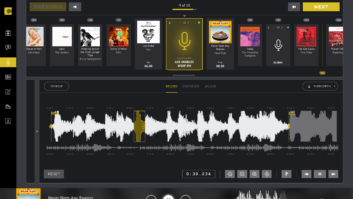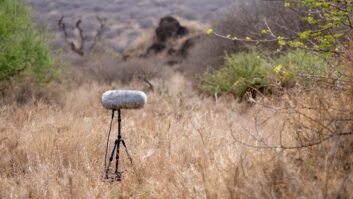The author is owner of SueMedia Productions.
In producing the original audio drama “The Witches of Lublin” for the broadcast market, I wanted to create a contemporary sound for the modern listening audience. I felt lucky to have had this moving and well-crafted play entrusted to me by its authors, and wanted to be sure that the sound served the story.

‘Witches’ was offered free to public radio stations in 2011, and producers hope it will become ‘a regular holiday special treat’ for Passover.
This meant considering the individual elements of the play, its voices, sound effects and music, and the best ways to record and mix them, so that they would transport listeners to 1797 Lublin, Poland, during the time of the Passover holiday, while engaging an audience used to the “cinematic sound” they hear in movie theaters.
“The Witches of Lublin” is based on research by ethnographer Yale Strom on the social history of klezmer music from the 14th century to the present day.In preparing his authoritative ethno-history “The Book of Klezmer,” Yale found references to women who played at large market fairs, an extremely rare occurrence. This was the seed from which he and his writing partners, Elizabeth Schwartz and Ellen Kushner, took their inspiration.
As executive producer and director, I began to work with the play in June 2010 for release by April 2011. I first worked with co-authors Ellen, Elizabeth and Yale on fine-tuning their play so that the dialogue and sound design best served their story, while fitting into a one-hour broadcast window.
We then began considering the chorus of voices that was to make up the cast. I wanted to record the actors in the same studio to maintain the overall sound; I needed to cast from the talent available to me (and our non-profit budget) in the New York area.
We began with the powerful dramatic actress Tovah Feldshuh (Tony nominated for “Golda’s Balcony”) in the lead as Rivke. We then auditioned many talented voice actors until we found the right mix to represent both the Jewish and Polish communities. Among our featured cast are the gifted Simon Jones (“Hitchhiker’s Guide to the Galaxy”), Barbara Rosenblat (Audie Winner for “Anne Frank Remembered”) and Neil Gaiman (“American Gods”).
By the end of September I was sure we had everything we needed to record, and that all I was waiting for was the recording date later in the fall.

Elizabeth Bodsky works on ‘Witches’ in the studios of WRHU.
Sonic storytelling
That is, I was sure until late October of 2010, when I attended Prix Europa in Berlin. Participating in its Audio Fiction Festival, I heard a somewhat different sound being produced by today’s European-based audio dramatists.
Abroad, the art is still vital. At Prix Europa, producers from all over the continent gather for a week of intense listening, sharing and critique of contemporary work. What I heard was a kind of sonic storytelling that drew the listener right into the space with the performers. You could hear the “room” and even the world around the recording space, as some of these dramas had been recorded outside the studio and on-location. Those recorded in the studio seemed to pay special attention to keeping the sound open and alive.
The piece that won the Audio Fiction competition, “Shadow House” from the Finnish Broadcast Company, featured the story of a woman going through her late mother’s home and packing up her belongings. For this play an actress was brought to a small private home, overlooking the shore, where she moved around the “set” performing the story while being recorded. The ways in which the house creaked and moaned as the actress moved added a layer of texture that brought the play to life for my ears in a new way.
When I got back I began to discuss with my recording engineer, David Shinn of SueMedia Productions, the fact that I did not want “The Witches” to have the typical close-mic flat studio sound heard in most American voice recordings; I wanted to capture the feeling of the place where these “Lublin” voices were, especially because some of the scenes take place in outdoor markets and large castle halls, with multiple characters and live music.
We agreed it would be best to record the actors at once in a large space, and to record the musicians in that same space in a live concert feel and not “wild track” them — all so that the actors and musicians could see each other while performing and to maintain sonic consistency. We would still isolate individual tracks of the multi-track recordings of the voices and musicians, but that was for flexibility in post-production and not to separate them in the recording space.
This meant finding a space large enough to host nearly a dozen actors and five musicians. Thrown into this mix was the fact that one of our featured actors, Neil Gaiman, could not record on the same day (or even in the same city) as everyone else. Also our vocalist needed to be isolated from the musicians so that her tracks could be switched out when the actors needed to be the singers.
Sense of closeness
Hofstra University station WRHU(FM) has a series of recording spaces that can be linked together if needed. Being an alumna of the station as well as a former administrative and academic member of the School of Communication, I spoke with Station Operations Manager John Mullin, who was able to work out a studio schedule.

Tovah Feldshuh played the lead character Rivke.
In recording the actors David used large-diaphragmcondenser microphones in a semi-circle in the largest studio, set up a minimum of three feet apart, keeping each microphone’s polar pattern in mind to reduce coloration. Among the mics used for voice were Neumann U 47, U 67, TLM 193, TLM 103 and TLM 102, set up so that the actors, who had only had a quick table read together the day before, could see each other.
This is a story about a small Jewish community that has lived together for generations, and the Polish nobles who rule over them. The performances needed to convey a sense of community. Actors were given headphones so they could hear themselves and each other as they performed.
The exception was the actor who substituted for Gaiman. In order to maintain the overall performances, Lucien Dodge was recorded in an isolation booth with headphones so that he could hear the rest of the cast and they could hear him as he performed the character of Bogdan. This allowed us to replace his temporary tracks for the final ones recorded a few weeks later via ISDN lines from Minneapolis Public Radio studios to a studio in New York City.
David brought our Mac tower with ProTools recording software, and a separate dedicated backup multi-track recorder, to capture all tracks. He recorded multi-track sessions so he could maintain whatever separation he was able to create with the placement of the microphones.
Because of budgets and schedules, the dialogue had to be recorded out of order in one nine-hour day. A production assistant, Eric Pahlke, notated each take on a master editing script, allowing us to reference recorded material for editing later.
The next day we set up for the musicians. As the story is about a small band of female klezmer musicians (a vocalist, and players of the tsimbl — similar to a hammered dulcimer — bass and violin), our composer, musical director and violinist Yale Strom hired tsimbl and bass players (Alexander Fedoriouk and Sprocket, respectively).
In an audio drama it is rare that any song is heard in its entirety. I discussed with Yale the idea of recording each song in full and maybe even adding a few related tunes, for a companion program. That way an audience could hear the entire song, with Yale’s original arrangements, and we could add a narrator to give historical information.

Simon Jones
Yale oversaw the selection of musical elements for the drama and for what became our second program, “The Devil’s Brides.” Elizabeth, Yale and Ellen collaborated on audio liner notes read by our narrator, British actress Miriam Margolyes. Since Miriam was in London, we worked with a studio in the U.K. to record her while I directed over the phone; the studio sent us the audio tracks via the Internet using FTP. Elizabeth Boskey performed vocals for the character of Sofia in “The Witches of Lublin.” Vocals for “The Devil’s Brides” were by Elizabeth Schwartz, a renowned klezmer vocalist.
For the musicians, David used a matched pair of AKG C 414s for the tsimbl, one for the treble side and one for the bass, and a TLM 193 capturing the sound overhead. The bass was recorded using a U 47 and U 67. For the violin he used the TLM 103. The singer was captured using a TLM 102. For the secondary tunes an accordion was added, played by Peter Stan. David used a Samson ribbon VR88 for the bass side of the accordion, with a TLM 193 capturing the treble side.
Overnight recording
After the primary voice and music tracks were completed, we turned to the sound effects needed to finish the sonic portrait of this 18th century community. Again I referred David to the recordings from Prix Europa, ones from Ireland and Britain in particular, in which the space played as much a character as any of the actors.
We decided that we could blend commercially released sound effects with on-location sounds that we recorded in an almost 100-year-old house. Listening for trains, planes, automobiles and other sounds of 21st century life, David and I found we could record “house sounds” beginning at 1 a.m. Sound effects artists Silvana Pinto and Butch D’Ambrosio were willing to work late at night to record the sounds we needed. David baffled the house with moving blankets, thick sheets of foam over windows and exhaust vents, and turned off noisy electronics (oil burners, fluorescent lights and refrigerators).
Using a Neumann TLM 193 and TLM 102 David was able to capture the many doors, chairs, footsteps, table pounding and more that were needed. These were then brought into the multi-track session which was mixed down to stereo for broadcast and CD replication and release.
In the spring of 2011, the program was offered free to stations through the Public Radio Exchange and PRSS ContentDepot, as well as on CD. It was heard on some 80 stations nationally as well as in Spain. For 2012 we are offering the program again for broadcast, hoping it will become a regular holiday special treat on many of our initial stations, and that new stations will want to pick up the one-hour audio drama “The Witches of Lublin” or the narrated musical special “The Devil’s Brides” (or both) as a Passover holiday special. We also created five short (3:30–10 minute) music features from “The Devil’s Brides,” which stations are invited to use through the spring holiday season. “The Witches of Lublin,” with its strong female cast and narrative, also makes a great International Women’s Day special for March.
In December, AudioFile Magazine counted“The Witches of Lublin” among The Best Full Cast Productions for 2011. In February the Audio Publisher’s Association nominated “Witches” for Audie Awards for Best Original Work and Best Package Design.
We’re hoping this coming Passover could be the “best time for radio drama.”
Sue Zizza is an award-winning audio drama director and producer. Projects include producing audiobooks and audio drama programming. She’s a member of the faculty at NYU, where she teaches audio recording and sound design to film students at the Tisch School of the Arts.
Learn about the program at www.thewitchesoflublin.com.












